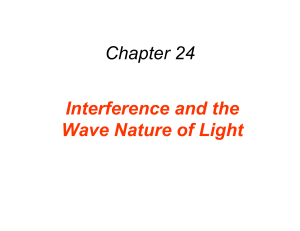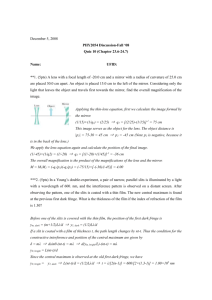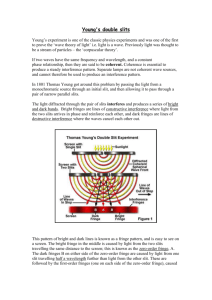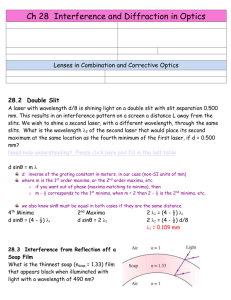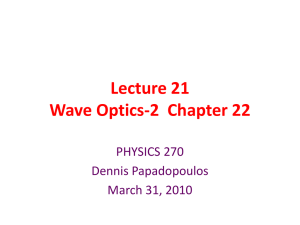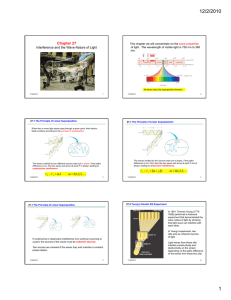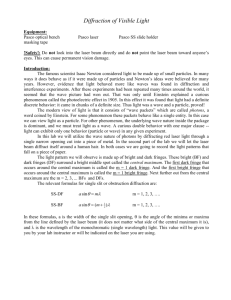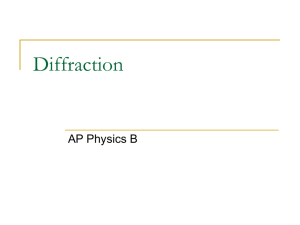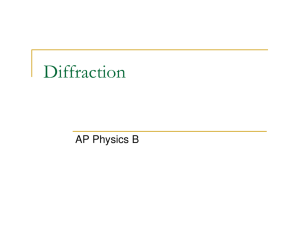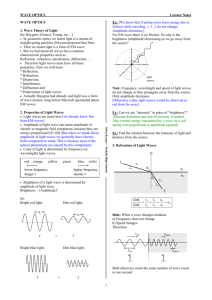Lab10_Wave Nature of Light
advertisement
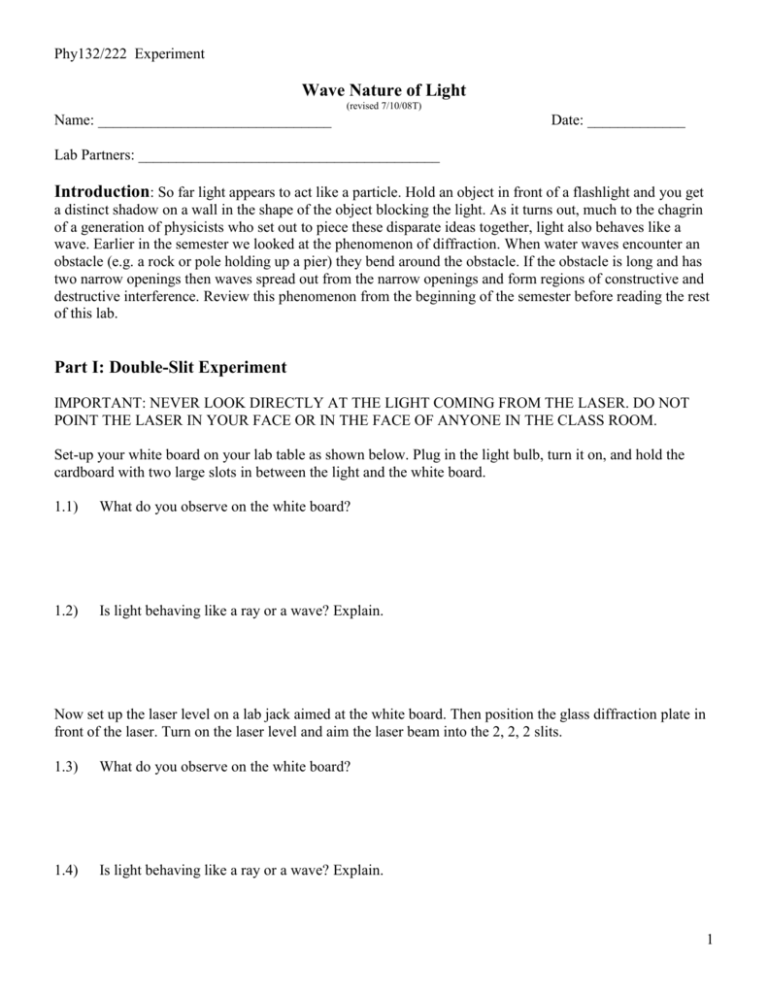
Phy132/222 Experiment Wave Nature of Light (revised 7/10/08T) Name: _______________________________ Date: _____________ Lab Partners: ________________________________________ Introduction: So far light appears to act like a particle. Hold an object in front of a flashlight and you get a distinct shadow on a wall in the shape of the object blocking the light. As it turns out, much to the chagrin of a generation of physicists who set out to piece these disparate ideas together, light also behaves like a wave. Earlier in the semester we looked at the phenomenon of diffraction. When water waves encounter an obstacle (e.g. a rock or pole holding up a pier) they bend around the obstacle. If the obstacle is long and has two narrow openings then waves spread out from the narrow openings and form regions of constructive and destructive interference. Review this phenomenon from the beginning of the semester before reading the rest of this lab. Part I: Double-Slit Experiment IMPORTANT: NEVER LOOK DIRECTLY AT THE LIGHT COMING FROM THE LASER. DO NOT POINT THE LASER IN YOUR FACE OR IN THE FACE OF ANYONE IN THE CLASS ROOM. Set-up your white board on your lab table as shown below. Plug in the light bulb, turn it on, and hold the cardboard with two large slots in between the light and the white board. 1.1) What do you observe on the white board? 1.2) Is light behaving like a ray or a wave? Explain. Now set up the laser level on a lab jack aimed at the white board. Then position the glass diffraction plate in front of the laser. Turn on the laser level and aim the laser beam into the 2, 2, 2 slits. 1.3) What do you observe on the white board? 1.4) Is light behaving like a ray or a wave? Explain. 1 What you should be observing on the white board is a central bright line (maxima), and a series of progressively fainter bright lines on either side (bright fringes). Constructive interference between two light waves creates the maxima and the bright fringes on either side. Destructive interference creates the black lines (dark fringes) in between the bright lines on the white board. This interference between two light waves behaves just like the interference between two sound waves that we studied earlier this semester. Be sure to review this on your own before the lab. Just like sound waves, the points of constructive and destructive interference for light are determined by the phase difference between the light waves at a point in space. If the path difference is an integer number of wavelengths then you will have constructive interference. Likewise, a half-integer number of wavelengths produce destructive interference. Using the figures below, we can determine the location of the bright fringes and dark fringes that we observe. y P r1 r2 θ 0 Δr = r2 – r1 L Figure 1 There are two narrow slits on the left a distance L from the white board. One location where the light waves meet will be at point P on the white board. Point P is a distance y from the midpoint of the white board and an angle θ from the midpoint between the slits. The two are related by y = L tanθ 2 Path length r1 Slit spacing d θ Path length r2 θ Δr = r2 – r1 Figure 2 (close up of Figure 1) One wave will travel a distance r1 from the top slit and the other a distance r2 from the bottom slit. If the path difference Δr = r2 – r1 is an integer multiple of wavelengths then we have constructive interference. Δr = nλ n = 0, 1, 2, 3, … In general, the distance d between the slits is much smaller than the length L. Therefore, r1 and r2 are essentially parallel and make an angle θ with the horizontal. From the close up view near the slit you can see that sinθ = Δr/d. Together with the previous result we see bright fringes occur at angles θ such that, Δr = d sinθn = nλ n = 0, 1, 2, 3, … The maxima is at n = 0, and each succeeding bright fringe starts with n = 1. The angle θ is usually very small. If that is the case we can use the small angle approximation sinθ ≈ θ, where θ is in radians. Θn = n λ/d n = 0, 1, 2, 3, … It is usually more convenient to measure the position of the nth bright fringe the viewing screen. This is the distance y from the center. Using the small angle approximation again, tanθ ≈ θ. Then y = Lθ with the relationship above gives us, yn = nλL/d n = 0, 1, 2, 3,… To make sure you are clear about what this relationship tells us. The case n = 0 corresponds to two light waves that have traveled the same distance from the slits to the screen forming a bright line from 3 constructive interference at the center of the screen. The case n = 1 is a bright fringe to the right or left of the maxima that is results from one light wave traveling one wavelength farther to reach the screen than the other. The case n = 2 would be one wave traveling two wavelengths farther, and so on. From this it is easy to show that the dark fringes of destructive interference are located at yn = (m+1/2)λL/d n = 0, 1, 2, 3, … Set up the glass diffraction plate 1.0 m from the white-board and adjust the laser level so that it can shine through the double slits. Place a piece of tape on the table at the location of you glass diffraction plate so that you can see if it moves during your experiment. Start with the 0.70 mm slit separation. (Your instructor will have a diagram that indicates which slit pair is indicated by the numbers in the far left column below. The slit pair corresponds to the slit separation d.) Measure the distance L to the white board and the distance y from the maxima to the first bright fringe on either side. Use these measurements to calculate the angle θ1 to the first bright fringe. Repeat for θ2. Calculate the wavelength of the light. Repeat for the other slits separations listed in your data table. Slit Pair Order d [ mm ] 2, 2, 14 1 0.70 2, 2, 14 2 0.70 2, 2, 6 1 0.35 2, 2, 6 2 0.35 2, 2, 2 1 0.176 2, 2, 2 2 0.176 2, 1, 2 1 0.132 2, 1, 2 2 0.132 L [ y ] [ Angle ] Wavelength [ ] Show Sample Calculation Below: 4 1.5) Compare your average value for λ to the accepted value. (Is this % error or % difference?) Part II: Single-Slit Diffraction Now we will look at the pattern formed when the laser light passes through a single narrow slit instead of two narrow slits side by side. Similar to before, L is the distance from the slit to the white board, yn is the distance to each successive bright fringe from the maxima (e.g. y1 is the distance from the maxima to the first bright fringe on your white board). The angle to each successive bright fringe from the maxima is θn. The width of the single slit will be designated by D. 2.1) Start with D = 1, 2. Aim the laser light at the slit 1.0 m from the white board. Describe the pattern you see. 2.2) Describe the intensity (brightness) of each successive bright fringe (n = 1, 2, 3, …) compared to the maxima (n = 0). 2.3) Start with D = 1, 8. Determine what happens to y1 and θ1 as you decrease D. 5 The relationship for single slit diffraction dark fringe locations is D sinθn = nλ n = 1, 2, 3,… 2.4) For the sine function, as θn increases the value of sinθn . 2.5) According to the relationship, as D increases the value of θn will . 2.6) Discuss how your statement in 2.3) agrees with the relationship. 2.7) According to the relationship, if D is kept constant, as the wavelength increases θn will . 2.8) Therefore, as the wavelength increases the distance between dark fringes should . 6 Challenge Problem: Diffraction Gratings Instead of having two narrow slits side by side, imagine that you had a hundred narrow slits side by side. That is what we call a diffraction grating. You will be provided with a diffraction grating. Your challenge will be to determine the “number of slits” per millimeter. Feel free to read up on diffraction gratings in your text to get a head start. Include a short description of what you measured and why, a data table, and show all calculations. Good Luck ! 7 8




